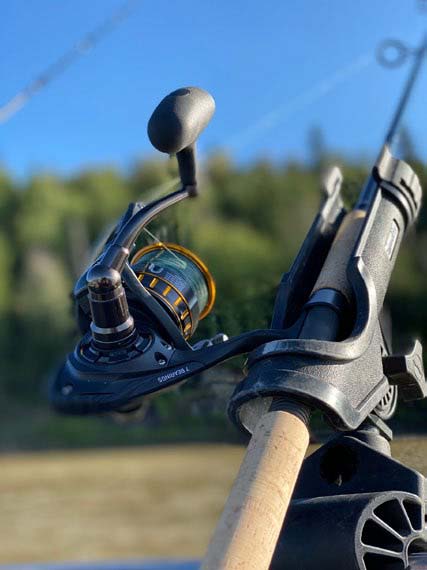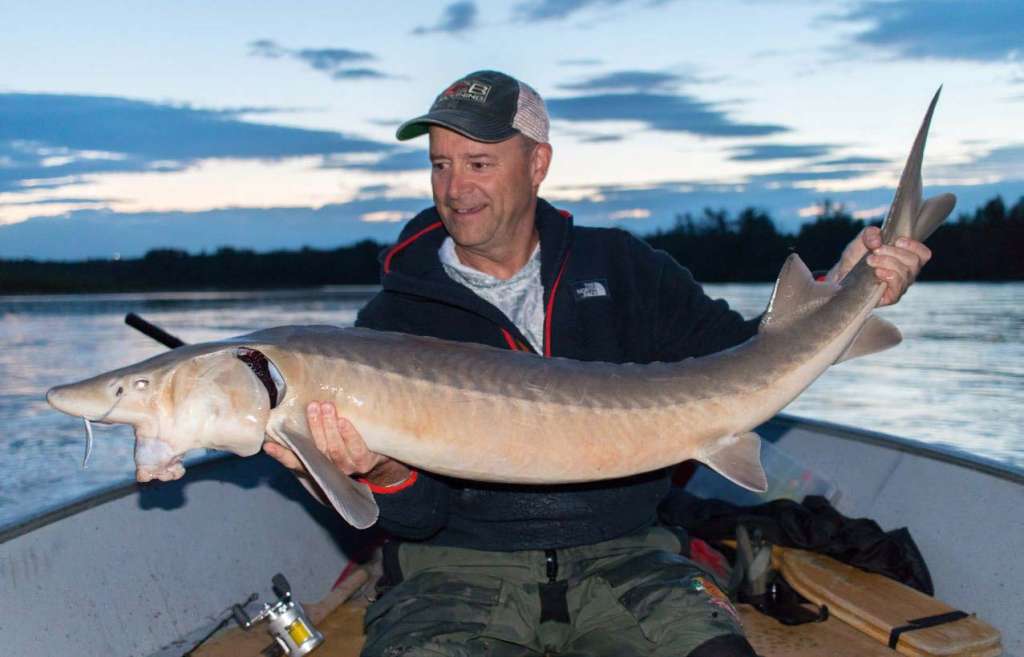
It’s a game of patience and attentiveness. Staring at my rod tip and line for what seemed like an eternity, I second-guessed myself when I say the most subtle ‘tick’. It barely moved. Knowing that a lake sturgeon take in the North Saskatchewan River can be oh so subtle, I carefully liberated my rod handle from the holder and set the hook with one smooth but firm motion. It felt like I’d snagged a log but the log began to swim away! Pumping and reeling, I knew I had to keep the big fish coming. Let him run into the heavy current and I’d be in big trouble. Lake sturgeon are unbelievably strong and they know how to use the current to their advantage. Ten minutes later, and after four different runs that each spooled at least fifty yards of line, I brought him to the boat. A handsome 40+ pound sturgeon was brought collected, quickly photographed, revived in hand and released. Difficult to explain in words, the raw power of these fish is simply amazing.
A much smaller cousin to the giant White Sturgeon of British Columbia’s Fraser River system, Lake Sturgeon are a totally unique and relatively untapped sportfish in western Canada. Although, with the covid shutdowns I will admit, a lot more anglers are accessing Alberta’s North and South Sasktatchewan, Red Deer and Bow River systems in search of this spectacular species as we speak.
Even though Lake Sturgeon are a smaller sub-species, fishing them still requires a unique combination of gear, knowledge and patience to be successful. With all the attention this species is getting nowadays, its time to talk about the do’s and don’ts for catching and releasing this protected prehistoric gamefish.
Rods & Tackle
From your rod to your reel, line, leader and hardware, if its not strong enough you’ll lose fish and tackle – I promise. For line, a minimum 30 lb. Power Pro works, but 40 lb. and even 50 lb. is fine. In some respects, the stronger it is, the better.
Both bait casting and spinning rod and reel combos work. From a boat I often use an Abu Garcia M5600C Ambassadeur reel and I’ve recently added a Daiwa BG 4500 spinning reel to my arsenal. A big game spinning reel allows you to reel in faster – a huge advantage when dealing with a fish that can use river current to its advantage. Employ a reel that can accommodate at least 200 yards of line, 300 is better. Sturgeon can take big runs and you don’t want to get spooled. An 8 to 10 ft. medium fast action 10-20 lb. or 10-30 lb. rod is most suitable for Alberta’s sturgeon. Two of my favourites are the G-Loomis Salmon Bounce and a Shimano Clarus. Considerations include stiffness of the blank and sensitivity of the tip, as sturgeon bites are often subtle.
Rigging
Rigging your line is simple. Use beads and either a sinker slider or heavy #7 ball bearing snap-swivel to attach your sinker. Most sturgeon anglers favour either 3, 4 or 5 oz. pyramid sinkers, but I’ve also had good success with round line-sinkers that allow you to feed the line directly through the weight itself. Tie your line to a #3 two-way barrel swivel. Sturgeon aren’t leader-shy, so for your leader, consider using either 50 lb. Big Game mono or 50 lb. Tuf Line Dacron.
Some prefer a bigger circle hook, but in my opinion its tough to beat a razor-sharp single 2/0 Gamakatsu Octopus hook. Minnows work well, but in my opinion, you can’t go wrong with dew worms. My friend Barry Butler taught me that the biggest mistake many anglers make is balling up as many worms as possible on the hook. Instead, feed the hook straight through the centre of the length of a single worm, and slide it as far up the hook and line as possible, leaving only the tip of the hook exposed.
In rivers, snags on rocks, logs and other debris are common. I’ve heard too many horror stories when it comes to pickerel rigs and sturgeon. One involved a sturgeon with a rig sticking part way out of its anus. For this reason and to minimize the amount of terminal tackle lost in the rivers, I generally discourage the use of pickerel rigs for sturgeon.
Knots are critical. Use an egg loop knot for tying the leader to your hook. It fastens the leader through the eye of the hook and locks it on to the shaft, making it durable and almost impossible for a fish to separate it from the hook. Either a Clinch knot or Palomar knot work well for connecting line to swivels.
Timing and Locations
While lake sturgeon can be caught throughout the summer, late spring (May and June) and fall (September and October) offer the best action. Midsummer can be good, but extreme warm temperatures can add undue stress to sturgeon. Even still, I’ve seen some amazing sturgeon fishing action in July and August as well. Remember, unlike other river dwelling fish, lake sturgeon grow slowly, and can live to 100 years of age. High water resulting from spring run-off conditions and rains produce a fast flow and good conditions for sturgeon fishing.
allow you to feed the line directly through the weight itself.
Sturgeon travel great distances on both the North Saskatchewan River (NSR) and the lower Red Deer River system, but the vast majority of Western Canada’s lake sturgeon action occurs in Alberta’s South Saskatchewan (SSR) and to a lesser extent in the NSR. Sturgeon monitoring records show that on the NSR, considerably higher densities and catch rates are recorded east of Edmonton toward the Smoky Lake area. Still relatively high numbers are caught in and east of Edmonton. The further west of the city you go, the lower the sturgeon densities and catch rates are. On the SSR, one of the most popular angling locations is still the forks where the SSR, Oldman and Bow River connect. From there, east to the Saskatchewan border holds higher numbers of sturgeon. The Sandy Point area and Rattlesnake Hole west of Medicine Hat are traditional hotspots.
To research more lake sturgeon fishing spots, visit the Alberta Outdoorsmen Message Board. Ask questions, and you’ll quickly gather a shortlist of known locations. Folklore suggests that sturgeon hold up only in deep holes. Over time I’ve come to learn that in fact flat, generally featureless river bottom areas tend to hold more sturgeon. It doesn’t seem to matter if its sandy, muddy or rocky, but rather how flat the bottom is. Calm backwaters around tight turns, behind islands, and even flats in wide open parts of the river with a consistent flat bottom can produce well. If you have a boat or can cast far enough, sometimes getting your bait out close to the seam between slack water and the fast flow can work well, but know that if you get a bite and your sturgeon runs into the current, you could be in trouble!
Feeding Behaviour
Sturgeon have a subterminal mouth and are bottom feeders. They move about on the river floor, nosing into the sand, mud and rocks with their snout, vacuuming up food like crayfish, nymphs, leeches, and other forage wherever they find it. Crustaceans actually make up a good portion of their diet in many areas, but be aware that it’s unlawful to use crayfish as bait.
Handle with Care
Always handle sturgeon with care. The official Alberta record caught in 1981, weighed in at 105 lbs. and in the spring of 2020 a much larger sturgeon, estimated to weigh close to 170 lbs. was caught in the SSR. A fish over 90 is estimated to be at least 60 to 75 years old, and their life expectancy can be over 100 years! With characteristically sharp bony scutes on their spine and particularly vulnerable gills, knowing how to handle them will not only protect you, but the fish as well.
Do your best not to exhaust sturgeon. Play them enough for safe handling, but recognize the fine line. Sturgeon are strong and even a small one can be a handful. Their open gills make them susceptible to bacterial infection if dragged through the mud or sand – something I see far too many anglers doing. Many anglers believe sturgeon are more resilient than other species due to their prehistoric appearance and longevity. I suggest the opposite is true. With bigger sturgeon, it’s best to use a cradle. This allows you to handle the fish in a safe manner while keeping it in the water. Whenever handling sturgeon, wet your hands first, or use fish handling gloves, before lifting them out of the water. Grip with one hand in between the dorsal and caudal fins, and hold the fish under the belly with the other behind the pectoral fins. Maintain a firm grip as they often appear docile, but when they decide to squirm, they’re extremely strong.
With sturgeon over 20-pounds consider handling them in the water only. Take photos quickly and release all sturgeon as soon as possible. In preparation for each release, face it into the current, and wait until it is revived enough to fin away on its own. Properly handling and releasing every sturgeon will help ensure that they recover well to be caught another day.
If you’ve never tried fishing for lake sturgeon, it’s time you did. They are challenging, but once you figure them out, you’ll tie into them on a routine basis. Fun to fight and a treat to see, they are one spectacular prehistoric-looking fish!
By Kevin Wilson

